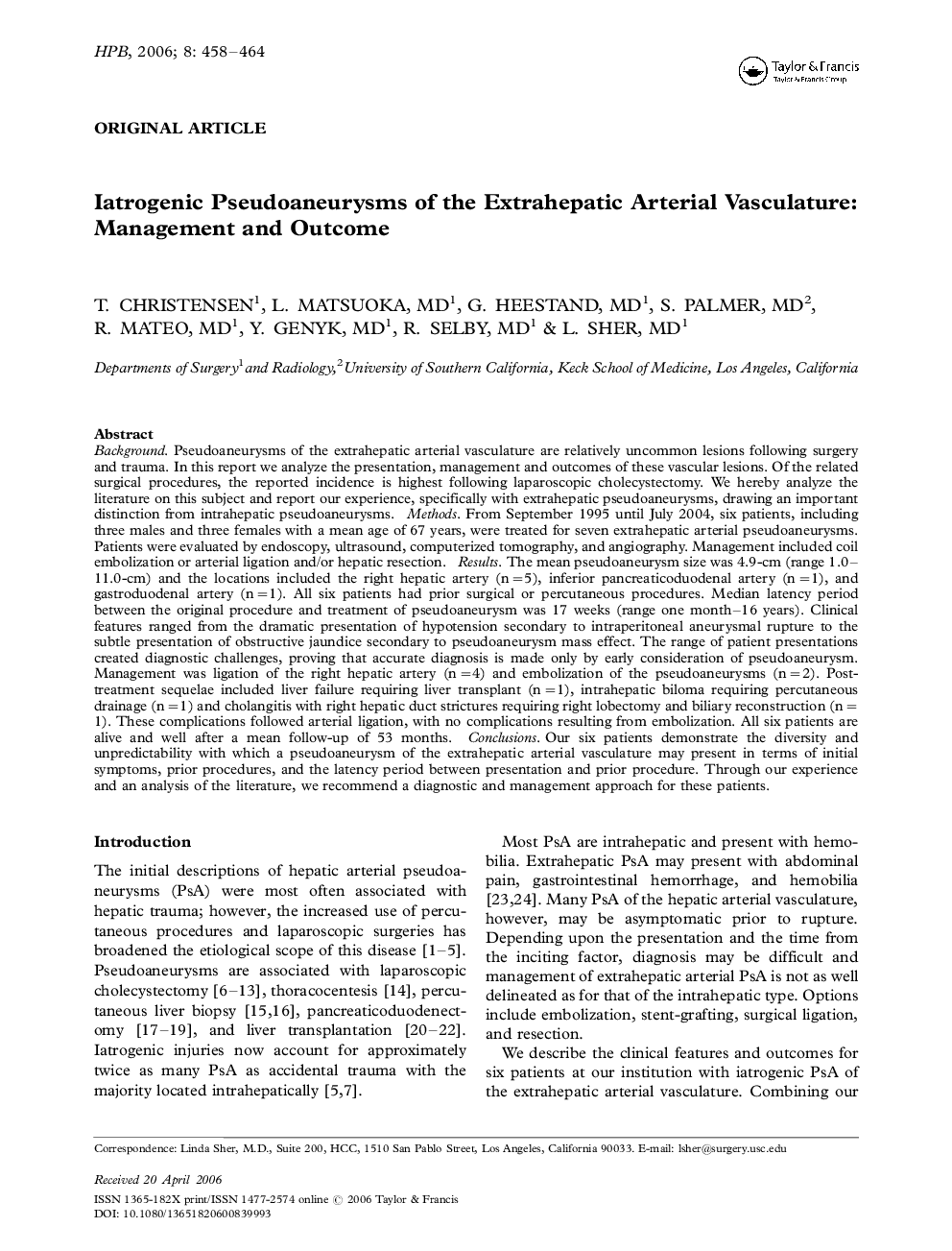| کد مقاله | کد نشریه | سال انتشار | مقاله انگلیسی | نسخه تمام متن |
|---|---|---|---|---|
| 3269972 | 1208179 | 2006 | 7 صفحه PDF | دانلود رایگان |
عنوان انگلیسی مقاله ISI
Iatrogenic Pseudoaneurysms of the Extrahepatic Arterial Vasculature: Management and Outcome
دانلود مقاله + سفارش ترجمه
دانلود مقاله ISI انگلیسی
رایگان برای ایرانیان
موضوعات مرتبط
علوم پزشکی و سلامت
پزشکی و دندانپزشکی
غدد درون ریز، دیابت و متابولیسم
پیش نمایش صفحه اول مقاله

چکیده انگلیسی
Background. Pseudoaneurysms of the extrahepatic arterial vasculature are relatively uncommon lesions following surgery and trauma. In this report we analyze the presentation, management and outcomes of these vascular lesions. Of the related surgical procedures, the reported incidence is highest following laparoscopic cholecystectomy. We hereby analyze the literature on this subject and report our experience, specifically with extrahepatic pseudoaneurysms, drawing an important distinction from intrahepatic pseudoaneurysms. Methods. From September 1995 until July 2004, six patients, including three males and three females with a mean age of 67 years, were treated for seven extrahepatic arterial pseudoaneurysms. Patients were evaluated by endoscopy, ultrasound, computerized tomography, and angiography. Management included coil embolization or arterial ligation and/or hepatic resection. Results. The mean pseudoaneurysm size was 4.9-cm (range 1.0-11.0-cm) and the locations included the right hepatic artery (n = 5), inferior pancreaticoduodenal artery (n = 1), and gastroduodenal artery (n = 1). All six patients had prior surgical or percutaneous procedures. Median latency period between the original procedure and treatment of pseudoaneurysm was 17 weeks (range one month-16 years). Clinical features ranged from the dramatic presentation of hypotension secondary to intraperitoneal aneurysmal rupture to the subtle presentation of obstructive jaundice secondary to pseudoaneurysm mass effect. The range of patient presentations created diagnostic challenges, proving that accurate diagnosis is made only by early consideration of pseudoaneurysm. Management was ligation of the right hepatic artery (n = 4) and embolization of the pseudoaneurysms (n = 2). Post-treatment sequelae included liver failure requiring liver transplant (n = 1), intrahepatic biloma requiring percutaneous drainage (n = 1) and cholangitis with right hepatic duct strictures requiring right lobectomy and biliary reconstruction (n = 1). These complications followed arterial ligation, with no complications resulting from embolization. All six patients are alive and well after a mean follow-up of 53 months. Conclusions. Our six patients demonstrate the diversity and unpredictability with which a pseudoaneurysm of the extrahepatic arterial vasculature may present in terms of initial symptoms, prior procedures, and the latency period between presentation and prior procedure. Through our experience and an analysis of the literature, we recommend a diagnostic and management approach for these patients.
ناشر
Database: Elsevier - ScienceDirect (ساینس دایرکت)
Journal: HPB - Volume 8, Issue 6, December 2006, Pages 458-464
Journal: HPB - Volume 8, Issue 6, December 2006, Pages 458-464
نویسندگان
T. Christensen, L. MD, G. MD, S. MD, R. MD, Y. MD, R. MD, L. M.D,